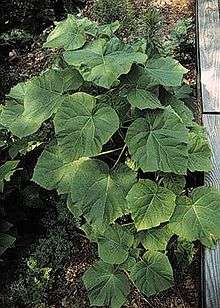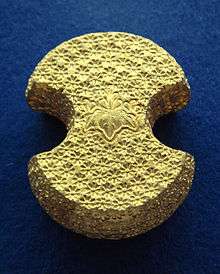Paulownia
| Paulownia | |
|---|---|
 | |
| Paulownia tomentosa foliage | |
| Scientific classification | |
| Kingdom: | Plantae |
| (unranked): | Angiosperms |
| (unranked): | Eudicots |
| (unranked): | Asterids |
| Order: | Lamiales |
| Family: | Paulowniaceae |
| Genus: | Paulownia Siebold & Zucc. |
| Species | |
|
Between 6-17 species, including: | |
Paulownia is a genus of 6 to 17 species (depending on taxonomic authority) of flowering plants in the family Paulowniaceae, related to and sometimes included in the Scrophulariaceae. They are present in much of China, south to northern Laos and Vietnam and are long cultivated elsewhere in eastern Asia, notably in Japan and Korea. They are deciduous trees 12–15 m (39–49 ft) tall, with large, heart-shaped leaves 15–40 cm across, arranged in opposite pairs on the stem. The flowers are produced in early spring on panicles 10–30 cm long, with a tubular purple corolla resembling a foxglove flower. The fruit is a dry capsule, containing thousands of minute seeds.

The genus, originally Pavlovnia but now usually spelled Paulownia, was named in honour of Anna Paulowna, queen consort of The Netherlands (1795–1865), daughter of Tsar Paul I of Russia. It is also called "princess tree" for the same reason.[1]
Paulownia is known to be an early colonizer of sterile soils (such as after a high temperature wildfire), because its seeds are easily killed off by soil fungi. In fact, it is so difficult to start Paulownia by seed that successful plantations purchase rootstock or seedlings—or propagate their own. Remarkably, despite the fact that seeds, seedlings, and roots of even mature trees are so susceptible to rot, the wood itself is not and is widely adored for boat building and surfboards.
Fossil record
Paulownia tomentosa once occurred in North America, but it is now considered an introduced species.[2][3] In an article in the American Journal of Botany, Charles J. Smiley reported finding fossils of Paulownia tomentosa leaves in Tertiary strata of Ellensburg Canyon of Washington state. Dr. Smiley described the structure of the leaves and, ruling out all similarly structured leaves, identified them positively as Paulownia. He examined fossils of many more trees in the Ellensburg formation and identified them as trees that normally co-habitate with Paulownia. He described the climate of what is now the northwestern United States during the Tertiary Period as being essentially ideal for the growth of Paulownia and he attributed extinction in North American Paulownia to glaciation in later ice ages.[4]
Paulownia macrofossils have been recovered from the late Zanclean stage of the Pliocene sites in Pocapaglia, Italy[5] and Paulownia caucasica macrofossils have been recovered from strata of the Serravallian stage of the Miocene in Georgia in the Caucasus region.[6]
Uses
In China, it is popular for roadside planting and as an ornamental tree. Paulownia needs a lot of light and does not like high water tables. Paulownia grown on plantations generally has widely spaced growth rings, meaning it's soft and of little value; wood with close growth rings is harder and of higher value. It is important in China, Korea, and Japan for making the soundboards of stringed musical instruments such as the guqin, guzheng, pipa, koto, and kayagum. It is also becoming more popular in the building of electric guitars, due to its affordability, availability, tone and looks.
Paulownia is also used in Chinese agroforestry systems because it grows fast, its wood is light but strong, its flowers are rich in nectar, its leaves make good fodder for farm animals, it is deep-rooting, and it is late-leafing and its canopy is quite sparse so that crops below it get both light enough to grow and shelter.[7]

Paulownia is known in Japanese as kiri (桐), specifically referring to P. tomentosa; it is also known as the "princess tree". It was once customary to plant a Paulownia tree when a baby girl was born, and then to make it into a dresser as a wedding present when she married. Paulownia is the mon of the office of prime minister and also serves as the emblem of the cabinet and the government (vis-à-vis the chrysanthemum being the Imperial Seal of Japan). It is one of the suits in hanafuda, associated with the month of December. Japan: An Illustrated Encyclopedia (page 1189; Tokyo: Kodansha, 1993. ISBN 4-06-931098-3) states:
Paulownia wood is very light, fine-grained, and warp-resistant. It is the fastest-growing hardwood. It is used for chests, boxes, and clogs (geta). Its low silica content reduces dulling of blades, making it a preferred wood for boxes to hold fine Japanese edge tools. The wood is burned to make charcoal for sketching and powder for fireworks, the bark is made into a dye. The silvery-grey wood is sliced into veneers for special visiting cards.[8]
More recently, it is used as body material for low-cost electric guitars and as the core for lightweight touring skis. It is often used in guitars as the core body, then laminated under a more durable wood, such as the Dean ML XM that is made of Paulownia as the body but is topped with mahogany.
Paulownia is extremely fast growing; up to 20 feet in one year when young. Some species of plantation Paulownia can be harvested for saw timber in as little as five years. Once the trees are harvested, they regenerate from their existing root systems, earning them the name of the "Phoenix tree."
As a forestry crop Paulownia are exacting in their requirements, performing well only in very well draining soil, with summer rainfall or availability of irrigation water.
Species
- Genus Paulownia
- Paulownia australis
- Paulownia catalpifolia
- Paulownia coreana (Paulownia tomentosa var. coreana)
- Paulownia duclouxii
- Paulownia elongata
- Paulownia fargesii
- Paulownia fortunei — Dragon tree.[9][10]
- Paulownia glabrata
- Paulownia grandifolia
- Paulownia imperialis
- Paulownia kawakamii
- Paulownia lilacina
- Paulownia longifolia
- Paulownia meridionalis
- Paulownia mikado
- Paulownia recurva
- Paulownia rehderiana
- Paulownia shensiensis
- Paulownia silvestrii
- Paulownia taiwaniana
- Paulownia thyrsoidea
- Paulownia tomentosa
- Paulownia viscosa
References
- ↑ Rush Industries, 2000.
- ↑ "Plants Profile for Paulownia tomentosa (princesstree)".
- ↑ "Paulownia tomentosa in Flora of China @ efloras.org".
- ↑ Smiley, Charles J. (February 1961). "A Record of Paulownia in the Tertiary of North America". American Journal of Botany. 48 (2): 175–179. doi:10.2307/2439100. JSTOR 2439100.
- ↑ Messian to Zanclean vegetation and climate of Northern and Central Italy by Adele Bertini & Edoardo Martinetto, Bollettino della Societa Paleontologica Italiana, 47 (2), 2008, 105-121. Modena, 11 lugio 2008.
- ↑ The History of the Flora and Vegetation of Georgia by Irina Shatilova, Nino Mchedlishvili, Luara Rukhadze, Eliso Kvavadze, Georgian National Museum Institute of Paleobiology, Tbilisi 2011, ISBN 978-9941-9105-3-1
- ↑ Yungying Wu and Zhaohua Zhu (1997). "5, Temperate Agroforestry in China". In Andrew M. Gordon and Steven M. Newman. Temperate Agroforestry Systems. Wallingford, Oxfordshire: CAB International. pp. 170–172. ISBN 9780851991474.
- ↑ Lincoln, William L. (1986). World Woods in Color. Fresno: Linden Publishing. p. 143.
- ↑ Virginia Tech: Paulownia fortunei — Dragon tree
- ↑ Wikimedia commons — Category: Paulownia fortunei — images.
External links
| Wikimedia Commons has media related to Paulownia. |
| Wikispecies has information related to: Paulownia |
- Paulownia forestry information
- Paulownia Research Center in China (Shaanxi) (in English)
- Flora of China - Paulownia
- Paulownia trees.org
- silvatree.com: Paulownia forestry
- fadr.msu.ru: "Paulownia, the Tree of Choice in China"
- fadr.msu.ru: "Paulownia, the Tree of Choice in China"
